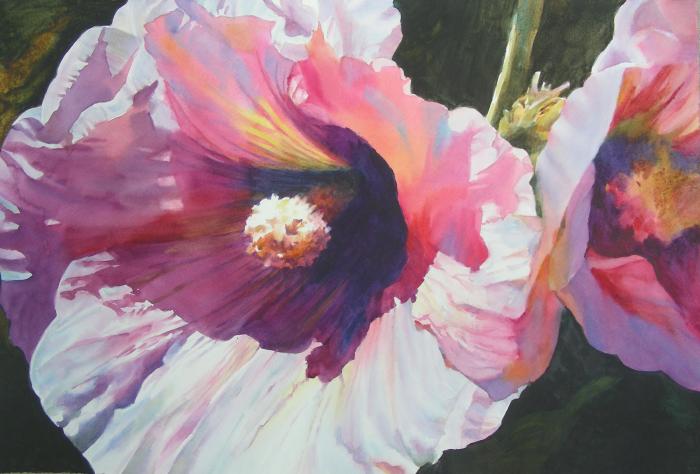Gertrude Stein famously remarked, “A rose is a rose is a rose,” suggesting that while a rose may seem simple, its meaning is often layered and complex. This sentiment resonates through history—from the memento mori of Dutch Baroque floral still life paintings that reflect on life’s transience to the Victorian era’s language of flowers, where roses represented devotion and rosemary stood for remembrance. The current exhibition at the Palo Alto Art Center, titled “GROW,” runs until December 15 and invites visitors to explore the intricate relationships between gardens, parks, plants, and artistic expression.
Curator’s Vision
Independent curator Marianne McGrath, who previously organized the exhibit “Feast and Famine” in January 2024, has spent the last four years conceptualizing “GROW.” In her quest to highlight themes of land, food, growth, and gardens, she meticulously researched and invited a diverse group of artists to contribute to the exhibition. McGrath emphasized the importance of relevance in today’s context, stating, “Is the work relevant to our collective moment, to the community, to the mission of the Palo Alto Art Center? I looked at the creativity, originality, and skill that went into making the work.”
She aimed to ensure that “GROW” showcases a variety of voices, perspectives, and interpretations, creating a multifaceted narrative about nature and its representation in art.
Diverse Mediums and Artistic Techniques
The exhibition features an impressive array of artistic media, ranging from paintings and photography to video presentations. Many artists have integrated multiple techniques to convey their messages effectively. One standout piece, “Windowsill” by Anna Valdez, combines oil, acrylic, and spray paint on canvas to depict a relatable domestic scene. For those who have lived in sterile urban apartments, Valdez’s work illustrates how gathering potted plants, hanging ivy, and cherished objects—like a cow’s skull and ceramic vessels—can transform and personalize confined living spaces.
Bright Colors with Serious Messages
Another notable work is “Against the Wall,” created by artists Jay Lynn Gomez and Patrick Martinez. This vibrant assemblage features a painted scene of a pink stucco wall adorned with lush red bougainvillea, complemented by a life-sized cardboard figure of a gardener trimming the vine while perched on a real ladder. The use of actual gardening tools adds to the trompe l’oeil effect, inviting viewers to engage with the artwork more deeply. For Gomez and Martinez, this piece holds personal significance; both artists come from immigrant families who performed domestic labor. Their work highlights the contributions of Hispanic workers, who are often the caretakers of the lavish gardens belonging to affluent families.
The Cycle of Life in Art
Many artists in “GROW” address the inevitable cycle of life, from birth to death, through their works. In “Decomposition Notes,” Connie Zheng employs rapid-fire imagery of her garden plants as they germinate, flourish, and decay, offering a poignant reflection on the passage of time. Stefan Kurten’s “Too Beautiful to Last” features a picturesque house and garden reminiscent of an Agatha Christie novel, rendered in acrylic, ink, and mother-of-pearl on linen. Kurten emphasizes that his idyllic scene is a constructed fantasy rather than a depiction of reality, revealing our collective desire to inhabit a worry-free, “perfect world.”
Nicholas Bono Kennedy’s piece, “Flower Market in Pink,” pays homage to the Dutch tradition of “vanitas,” which symbolizes the transient nature of life through still-life art. This vivid acrylic and oil painting showcases a bustling farmers’ market filled with cut flowers, which, although beautiful, serve as a reminder of their own mortality. Interspersed throughout the vibrant floral display are elements of indulgence, such as an overflowing ashtray and a calorie-rich almond croissant, suggesting humanity’s attraction to beauty despite its potential harm.
Diversity and Inclusion in Floral Themes
While floral-themed art may seem disconnected from the themes of diversity and inclusion, Glenn Hardy, Jr. successfully weaves these concepts into his life-size portrait, “Untitled.” Defying the historical stereotype of white figures in garden settings, Hardy presents a tall Black man adorned with sunglasses and a do-rag, posed under an arbor of bright pink flowers. The subject’s broad smile and relaxed demeanor challenge societal norms, as Hardy aims to depict Black individuals enjoying moments of comfort, relaxation, and triumph. This striking portrayal serves as a powerful commentary on representation in art.
Community and Urban Greenspaces
Art captures moments in time, both significant and ordinary. Jose Joaquin Figueroa’s work illustrates a typical day at a local landmark—Dolores Park in San Francisco. Through diminutive glazed ceramic figures, crafted in an almost child-like manner, Figueroa celebrates the park as a vital community gathering point. His diorama and accompanying 27 watercolor drawings depict the diverse population that frequents this urban oasis, where residents engage in activities such as yoga, reading, picnicking, or playing with dogs. Figueroa notes, “Dolores Park is an ideal place to relax and get a sense of San Francisco’s vibe,” emphasizing the importance of public spaces in fostering community connection.
Conclusion: A Flourishing Narrative
The “GROW” exhibition at the Palo Alto Art Center presents an impressive array of artworks that delve into the complex relationships between nature, culture, and identity. Through a diverse selection of media and themes, the exhibition invites viewers to reflect on their connections to gardens, parks, and the broader natural world.
By showcasing the contributions of artists from various backgrounds and perspectives, “GROW” highlights the profound meanings that can be derived from seemingly simple subjects like flowers and gardens. The exhibition not only celebrates the beauty of nature but also encourages critical conversations about the role of art in understanding our shared experiences and the world around us.
As the exhibition runs until December 15, visitors are encouraged to explore the rich tapestry of ideas and emotions woven into the artworks, celebrating the power of art to illuminate the intricacies of life, identity, and community.
Related topics:

